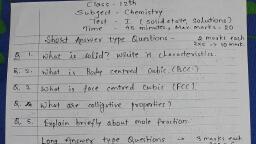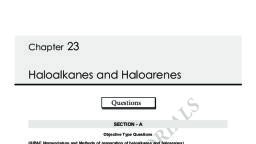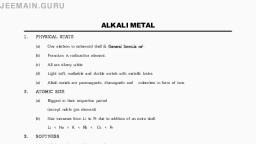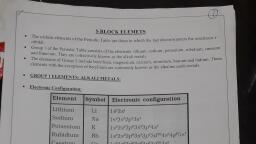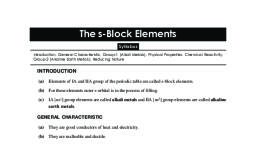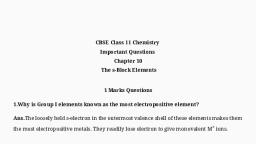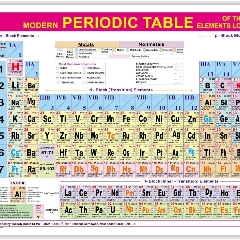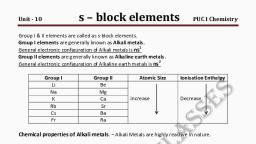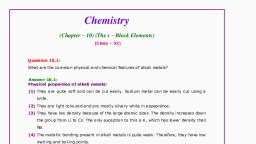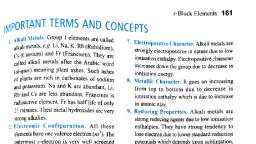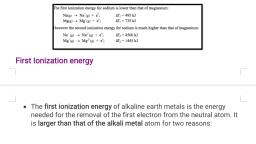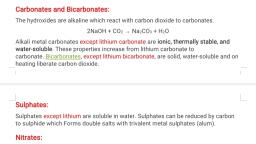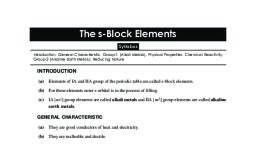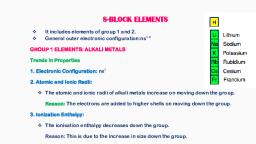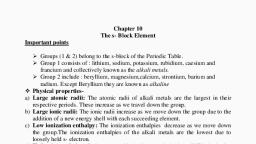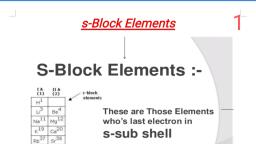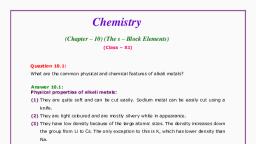Page 1 :
The s-Block Elements, , Chapter 3 - The s-Block Elements, Page No 305:, , Question 10.1:, What are the common physical and chemical features of alkali metals?, Answer:, , Physical properties of alkali metals are as tollows., (1) They are quite soft and can be cut easily. Sodium metal can be easily cut using a knife., (2) They are light coloured and are mostly silvery white in appearance., , (3) They have low density because of the large atomic sizes. The density increases down, the group from Li to Cs. The only exceptionto this isk, which has lower density than Na., (4) The metallic bonding present in alkali metals is quite weak. Therefore, they have low, , melting and boiling points., (5) Alkali metals and their salts impart a characteristic colour to flames. This is because, the heat from the flame excites the electron present in the outermost orbital to a high, energy level. When this excited electron reverts back to the ground state, it emits excess, energy as radiation that fallis in the visible region., , (6) They also display photoelectric effect. When metals such as Cs and K are irradiated, with light, they lose electrons., Chemical properties of alkali metals, Alkali metals are highly reactive due to their low ionization enthalpy. As we move down the, group, the reactivity increases., , (1) They react with water to form respective oxides or hydroxides. As we move down the, group, the reaction becomes more and more spontaneous., , (2) They react with water to form their respective hydroxides and dihydrogens. The, general reaction for the same is given as, 2M+2H,0, , 2M+ 20H H2, , (3) They react with dihydrogen to form metal hydrides. These hydrides are ionic solids and, have high melting points., , 2M+H,, , 2M'H, , (4) Almost all alkali metals, except Li, react directly with halogens to form ionic halides., , 2M+Cl, , 2MCI, , (M Li, K, Rb,Cs), , Since Li ion is very small in size, it can easily distort the electron cloud around the, negative halide ion. Therefore, lithium halides are covalent in nature.
Page 2 :
(5) They are strong reducing agents. The reducing power of alkali metals increases on, moving down the group. However, lithium is an exception. It is the strongest reducing, agent among the alkali metals. It is because of its high hydration energy., (6) They dissolve in liquid ammonia to form deep blue coloured solutions. These solutions, are conducting in nature., , M-(r)NH,-[M(NH,),J -M(NH,), ], The ammoniated electrons cause the blue colour of the solution. These solutions are, paramagnetic and if allowed to stand for some time, then they liberate hydrogen. This, results in the formation of amides., , Mte +NH, , MNH, , H, , In a highly concentrated solution, the blue colour changes to bronze and the solution, , becomes diamagnetic., , Question 10.2:, , Discuss the general characteristics and gradation in properties of alkaline earth metals., Answer:, , General characteristics of alkaline earth metals are as follows., , () The general electronic configuration of alkaline earth metals is [noble gas| ns., (i) These metals lose two electrons to acquire the nearest noble gas configuration., Therefore, their oxidation state is +2., , (ii)These metals have atomic and ionic radii smaller than that of alkali metals. Also, when, moved down the group, the effective nuclear charge decreases and this causes an, increase in their atomic radii and ionic radii., , (iv)Since the alkaline earth metals have large size, their ionization enthalpies are found to, be fairly low. However, their first ionization enthalpies are higher than the corresponding, group 1 metals., , (v) These metals are lustrous and silvery white in appearance. They are relatively less soft, as compared to alkali metals., (vi) Atoms of alkaline earth metals are smaller than that of alkali metals. Also, they have, two valence electrons torming stronger metalic bonds. These two factors cause alkaline, earth metals to have high melting and boiling points as compared to alkali metals., , (vii) They are highly electropositive in nature. This is due to their low ionization enthalpies., Also, the electropositive character increases on moving down the group from Be to Ba., , (vii) Ca, Sr, and Ba impart characteristic colours to flames., , Ca-Brick red, , Sr, , Crimson red, , Ba-Apple green, In Be and Mg, the electrons are too strongly bound to be excited. Hence, these do not, , impart any colour to the flame., The alkaline earth metals are less reactive than alkali metals and their reactivity increases, , on moving down the group. Chemical properties of alkaline earth metals are as follows., ) Reaction with air and water: Be and Mg are almost inert to air and water because of the, formation of oxide layer on their surface., , (a) Powdered Be burns in air to form BeO and BegN, , 2
Page 3 :
(a) Powdered Be burns in air to form BeO and BegN2, (b) Mg, being more electropositive, burns in air with a dazzling sparkle to form MgO and, , MggN2, (c) Ca, Sr, and Ba react readily with air to form respective oxides and nitrides., (d) Ca, Ba, and Sr react vigorously even with cold water., (i) Alkaline earth metals react with halogens at high temperatures to form halides., , M+X,, , MX, (X = F.Cl, Br,1), , (ii) All the alkaline earth metals, except Be, react with hydrogen to form hydrides., , (iv) They react readily with acids to form salts and liberate hydrogen gas., , M+2HCI, , MCI, +HT, , (v) They are strong reducing agents. However, their reducing power is less than that of, alkali metals. As we move down the group, the reducing power increases., (vi) Similar to alkali metals, the alkaline earth metals also dissolve in liquid ammonia to, give deep blue coloured solutions., , M+(r-y)NH, [M(NH,),]2«(NH,), ], Question 10.3:, Why are alkali metals not found in nature?, Answer:, Alkali metals include lithium, sodium, potassium, rubidium, cesium, and francium. These, metals have only one electron in their valence shell, which they lose easily, owing to their, low ionization energies. Therefore, alkali metals are highily reactive and are not found in, nature in their elemental state., , Question 10.4:, , Find the oxidation state of sodium in, , NagOp, , Answer:, Let the oxidation state of Na be x. The oxidation state of oxygen, in case of peroxides, is., , Therefore,, 2()+2(-1) =0, 2x-2=0, , 2x 2, , x=+1|, Therefore, the oxidation sate of sodium is +1.
Page 4 :
Question 10.5:, , Explain why is sodium less reactive than potassium?, Answer:, , In alkali metals, on moving down the group, the atomic size increases and the etfective, nuclear charge decreases. Because of these factors, the outermost electron in potassium, can be lost easily as compared to sodium. Hence, potassium is more reactive than, sodium., , Question 10.6:, Compare the alkali metals and alkaline earth metals with respect to (i) ionization enthalpy, (i) basicity of oxides and (ii) solubility of hydroxides., Answer:, Alkali metals, , ), , lonization enthalpy:, , These have lowest ionization, , Alkaline earth metals, , i) lonization enthalpy:, , Alkaline earth metals have smaller atomic size, , enthalpies in respective, , and higher effective nuclear charge as compared, , periods. This is because of, their large atomic sizes. Also,, they lose their only valence, electron easily as they attain, , to alkali metals. This causes their first ionization, , stable noble gas configuration, after losing it., , Cii) Basicity of oxides:, , The oxides of alkali metals, are, , very basic in nature. This, , happens due to the highly, , electropositive nature of alkali, metals, which makes these, , oxides highly ionic. Hence,, they readily dissociate in, water to give hydroxide ions., , enthalpies to be higher than that of alkali metals, However, their second ionization enthalpy is less, , than the corresponding alkali metals. This is, , because alkali metals, after losing one electron,, acquires noble gas configuration, which is very, stable., , i) Basicity of oxides:, , The oxides of alkaline earth metals are quite basic, , but not as basic as those of alkali metals. This is, because alkaline earth metals are less, electropositive than alkali metals.
Page 5 :
Gii) Solubility of hydroxides:, , ii) Solubility of hydroxides:, , The hydroxides of alkali, metals are more soluble than, those of alkaline earth metals., , The hydroxides of alkaline earth metals are less, soluble than those of alkali metals. This is due to, the high lattice energies of alkaline earth metals., , Their higher charge densities (as compared to, , alkali metals) account for higher lattice energie, , Question 10.7:, In what ways lithium shows similarities to magnesium in its chemical behaviour?, , Answer:, Similarities between lithium and, , magnesium, , are as, , follows., , (i) Both Li and Mg react slowly with cold water., (i) The oxides of both Li and Mg are much less soluble in water and their hydroxides, decompose at high temperature., , 2LiOH, , Li,0+H,O, , Mg(OH)., , MgO+HO, , (ii) Both Li and Mg react with Ng to form nitrides, , 6Li+N, , 3Mg+N, , 2Li,N, Mg,N,, , (iv) Neither Li nor Mg form peroxides or superoxides., (v) The carbonates of both are covalent in nature. Also, these decompose on heating., , Li,CO,, , Li,0+C0, , MgCO,, , MgO+CO,, , (vi) Li and Mg do not form solid bicarbonates., (vii) Both Licl and MgCl2 are soluble in ethanol owing to their covalent nature., , (vii) Both LiCI and MgCl2 are deliquescent in nature. They crystallize from aqueous, , solutions as hydrates, tor example, LICI-2H,0 and, , MgCl, 8H,0, , 5
Page 6 :
MgCl, 8H,0, Question 10.8:, Explain why alkali and alkaline earth metals cannot be obtained by chemical reduction, methods?, , Answer, In the process of chemical reduction, oxides of metals are reduced using a stronger, reducing agent. Alkali metals and alkaline earth metals are among the strongest reducing, agents and the reducing agents that are stronger than them are not available. Therefore,, they cannot be obtained by chemical reduction of their oxides., , Question 10.9:, , Why are potassium and cesium, rather than lithium used in photoelectric cells?, , Answer:, All the three, lithium, potassium, and cesium, are alkali metals. Still, K and Cs are used in, the photoelectric cell and not Li., This is because as compared to Cs and K, Li is smaller in size and therefore, requires high, , energy to lose an electron. While on the other hand, K and Cs have low ionization energy., Hence, they can easily lose electrons. This property of K and Cs is utilized in photoelectric, , cells., , Question 10.10:, When an alkali metal dissolves in liquid ammonia the solution can acquire different, colours. Explain the reasons for this type of colour change., Answer:, , When an alkali metal is dissolved in liquid ammonia, it resu ts in the tormation of a deep, , blue coloured solution., , M+(r+) NH,, , M (NH,), +«"(NH,),, , The ammoniated electrons absorb energy corresponding to red region of visible light., Therefore, the transmitted light is blue in colour., , At a higher concentration (3 M), clusters of metal ions are formed. This causes the, solution to attain a copper-bronze colour and a characteristic metallic lustre., , 6
Page 7 :
Question 10.11:, , Beryllium and magnesium do not give colour to flame whereas other alkaline earth metals, do so. Why?, Answer:, When an alkaline earth metal is heated, the valence electrons get excited to a higher, , energy level. When this excited electron comes back to its lower energy level, it radiates, energy, which belongs to the visible region. Hence, the colour is observed. In Be and Mg., , the electrons are strongly bound. The energy required to excite these electrons is very, high. Therefore, when the electron reverts back to its original position, the energy released, does not fall in the visible region. Hence, no colour in the flame is seen., , Question 10.12:, Discuss the various reactions that occur in the Solvay process., Answer:, , Solvay process, , 7, , used to prepare sodium carbonate., , When carbon dioxide gas is bubbled through a brine solution saturated with ammonia,, sodium hydrogen carbonate is formed. This sodium hydrogen carbonate is then converted, to sodium carbonate., , Step 1: Brine solution is saturated with ammonia., , 2NH, +H,0+CO,, , (NH,), CO,, , This ammoniated brine is filtered to remove any impurity., Step 2: Carbon dioxide is reacted with this ammoniated brine to result in the formation of, insoluble sodium hydrogen carbonate., , NH3+H20+C02 NH4HCO3NaCl+NH4HCO3NaHCO3+NH4CI, Step 3: The solution containing crystals of NaHCOg is filtered to obtain NaHCOg, Step 4: NaHCOg is heated strongly to convert it into NaHCO3, , 2NaHCO,, , Na,CO, +CO, +H,0, , Step 5: To recover ammonia, the filtrate (after removing NaHCOg) is mixed with, Ca(OH)2and heated., , Ca(OH)2+2NH4C12NH3+2H20+CaC12, The overall reaction taking place in Solvay process is 2NaCI +CaCO,, , Na,cO, +CaCl, , Question 10.13:, , Potassium carbonate cannot be prepared by Solvay process. Why?, , Answer:, , Solvay process cannot be used to prepare potassium carbonate. This is because unlike, sodium bicarbonate, potassium bicarbonate is fairly soluble in water and does not, precipitate out.
Page 8 :
Question 10.14:, , Why is LigCOg decomposed at a lower temperature whereas NagCOg at higher, temperature?, Answer:, As we move down the alkali metal group, the electropositive character increases. This, , causes an increase in the stability of alkali carbonates. However, lithium carbonate is not, so stable to heat. This is because lithium carbonate is covalent. Lithium ion, being very, small in size, polarizes a large carbonate ion, leading to the formation of more stable, lithium oxide., , Li.CO,, , 8, , Li,0+CO, , Therefore, lithium carbonate decomposes at a low temperature while a stable sodium, carbonate decomposes at a high temperature., , Page No 306:, Question 10.15:, , Compare the solubility and thermal stability of the following compounds of the alkali, metals with those of the alkaline earth metals. (a) Nitrates (b) Carbonates (c) Sulphates., , Answer:, () Nitrates, Thermal stability, Nitrates of alkali metals, except LiNOg, decompose on strong heating to form nitrites., , 2KNO 2KNO4, +0, LiNOg., , on, , decomposition, gives, , 2LiNO, , oxide., , Li,0,+2NO+ON, , Similar to lithium nitrate, alkaline earth metal nitrates also decompose to give oxides., , 2Ca(NO,)., , +2Ca0, +4NO,,+O, , As we move down group 1 and group 2, the thermal stability of nitrate increases., , Solubility
Page 9 :
Nitrates of both group 1 and group 2 metals are soluble in water., , (i) Carbonates, Thermal stability, , The carbonates of alkali metals are stable towards heat. However, carbonate of lithium,, when heated, decomposes to form lithium oxide. The carbonates of alkaline earth metals, also decompose on heating to form oxide and carbon dioxide., , Na,CO,, , Noeffect, , Lico,, MgcO,, , Li,0+co,, MgO+co,, , Solubility, Carbonates of alkali metals are soluble in water with the exception of LigCOg. Also, the, solubility increases as we move down the group., Carbonates of alkaline earth metals are insoluble in water., , (Gii) Sulphates, Thermal stability, Sulphates of both group 1 and group 2 metals are stable towards heat., , Solubility, Sulphates of alkali metals are soluble in water. However, sulphates of alkaline earth, metals show varied trends., , BesO4 Fairly soluble, Mgso, Soluble, Ca$04 Sparingly soluble, SrSO4 Insoluble, BaSO4 Insoluble, In other words, while moving down the alkaline earth metals, the solubility of their, sulphates decreases., , Question 10.16:, , Starting with sodium chloride how would you proceed to prepare (i) sodium metal (ii), sodium hydroxide (ii) sodium peroxide (iv) sodium carbonate?, Answer:, , (a) Sodium can be extracted from sodium chloride by Downs process., , 9
Page 10 :
This process involves the electrolysis of fused NaCI (40%) and CaCl2 (60 %) at a, temperature of 1123 K in Downs cell., Chlorine, , -, , -, , Fused, , Molten sodium, metal, , NaCl+CaCl, Cathode, (Iron), , Anode, , (Graphite), , Steel is the cathode and a block of graphite acts as the anode. Metallic Na and Ca are, formed at cathode. Molten sodium is taken out of the cell and collected over kerosene., , NaCletnhis, , Na +Cl, , Molten, , At Cathode: Na' +e At Anode:, , C, , +e, , CI +CI, , Na, , CI, Cl,, , (i) Sodium hydroxide can be prepared by the electrolysis of sodium chloride. This is called, Castner-Kellner process. In this process, the brine solution is electrolysed using a carbon, , anode and a mercury cathode., The sodium metal, which is discharged at cathode, combines with mercury to form an, , amalgam., Cathode: Na' +e N a - amalgam, Anode: C, , 10, , (ii) Sodium peroxide, First, NaCI is electrolysed to result in the formation of Na metal (Downs process)., This sodium metal is then heated on aluminium trays in air (free of COg) to form its, peroxide., , 2Na+Oar, , Na,O, , (iv) Sodium carbonate is prepared by Solvay process. Sodium hydrogen carbonate is, precipitated in a reaction of sodium chloride and ammonium hydrogen carbonate., , 2NH, +H,O+co,(NH,), CO,, , (NH),CO, +H,0+cO,2NH,HCOo,, NH,HCO, + NaCl, , NH,C1+ NaHco,, , These sodium hydrogen carbonate crystals are heated to give sodium carbonate., , 2NaHCO, , Na,cO,+co +H,O
Page 11 :
Question 10.17:, What happens when (i) magnesium is burnt in air (ii) quick lime is heated with silica (ii), , chlorine reacts with slaked lime (iv) calcium nitrate is heated ?, Answer:, , () Magnesium burns in air with a dazzling light to form MgO and MgaN2, , 2Mg+O,, , 2MgO, , 3Mg+N, n, , > Mg,N, , (i) Quick lime (Ca0) combines with silica (SiOg) to torm slag., , Ca0+SiO,, , CaSiO,, , (ii) When chloride is added to slaked lime, it gives bleaching powder., , Ca(OH), +C1,, , CaOC1, +H,0, Bleaching, powder, , (iv) Calcium nitrate, on heating, decomposes to give calcium oxide., , 2Ca(NO,), , 2Ca0+4NO,+01), , Question 10.18:, Describe two important uses of each of the following: () caustic soda (i) sodium, carbonate (Gii) quicklime., Answer:, , (i) Uses of caustic soda, (a) It is used in soap industry., (b) It is used as a reagent in laboratory., , (i) Uses of sodium carbonate, (a) It is generally used in glass and soap industry., (b) It is used as a water softener., , (i) Uses of quick lime, (a) It is used as a starting material for obtaining slaked lime., (b) It is used in the manufacture of glass and cement., , 11
Page 12 :
Question 10.19:, , Draw the structure of () BeCl2 (vapour) (i) Be Cl2 (solid)., Answer:, , (a) Structure of BeCl (solid), BeCla exists as a polymer in condensed (solid) phase., , Se, , 9, , 8, , o 3 pm, , In the vapour state, BeCl2 exists as a monomer with a linear structure., , CI - Be, , Be--CI, , Question 10.20:, , The hydroxides and carbonates of sodium and potassium are easily soluble in water while, the corresponding salts of magnesium and calcium are sparingly soluble in water. Explain., Answer:, , The atomic size of sodium and potassium is larger than that of magnesium and calcium., Thus, the lattice energies of carbonates and hydroxides formed by calcium and, magnesium are much more than those of sodium and potassium. Hence, carbonates and, hydroxides of sodium and potassium dissolve readily in water whereas those of calcium, and magnesium are only sparingly soluble., , Question 10.21:, Describe the importance of the following: () limestone (ii) cement (ii) plaster of paris., Answer:, , (i) Chemically, limestone is CaCOa, Importance of limestone, , (a) It is used in the preparation of lime and cement., (b) It is used as a flux during the smelting of iron ores., , (i) Chemically, cement is a mixture, , calcium silicate and calcium aluminate., , Importance of cement, , (a) lt is used in plastering and in construction of bridges., , (b) t is used in concrete., (ii) Chemically, plaster of Paris is 2CaSO.Ha0., Importance of plaster of Paris, , (a) It is used in surgical bandages., (b) It is also used for making casts and moulds., , 12
Page 13 :
Question 10.22:, , Why are lithium salts commonly hydrated and those of the other alkali metal ions usually, , anhydrous?, Answer:, Lithium is the smallest in size among the alkali metals. Hence, Lit ion can polarize water, molecules more easily than other alkali metals. As a result, water molecules get attached, to lithium salts as water of crystallization. Hence, lithium salts such as trihydrated lithium, chloride (LiCl.3H20) are commonly hydrated. As the size of the ions increases, their, polarizing power decreases. Hence, other alkali metal ions usually form anhydrous salts., , Question 10.23:, , Why is LiF almost insoluble in water whereas LiCl soluble not only in water but also in, , acetone?, Answer:, LiF is insoluble in water. On the contrary, LiCl is soluble not only in water, but also in, , acetone. This is mainly because of the greater ionic character of LIF as compared to Licl., The solubility of a compound in water depends on the balance between lattice energy and, , hydration energy. Since fluoride ion is much smaller in size than chloride ion, the lattice, energy of LiF is greater than that of LiC. Also, there is not much difference between the, , hydration energies of fuoride ion and chloride ion. Thus, the net energy change during the, dissolution of LiCI in water is more exothermic than that during the dissolution of LiF in, water. Hence, low lattice energy and greater covalent character are the factors making, LiCl soluble not only in water, but also in acetone., , Question 10.24, Explain the significance of sodium, potassium, magnesium and calcium in biological fluids., , Answer:, Importance of sodium, potassium, magnesium, and calcium in biological fluids:, , () Sodium (Na):, Sodum ions are found primarily in the biood plasma. They are also found in the interstitial, fluids surrounding the cells., , (a) Sodium ions help in the transmission of nerve signals., (b) They help in regulating the flow of water across the cell membranes., , (e) They also help in transporting sugars and amino acids into the cells., (i) Potassium (K):, Potassium ions are found in the highest quantity within the cell filuids., (a) K ions help in activating many enzymes., , (6) They also participate in oxidising glucose to produce ATP, (c) They also help in transmitting nerve signals., (ii) Magnesium (Mg) and calcium (Ca):, Magnesium and calcium are referred to as macro-minerals. This term indicates their, higher abundance in the human body system., , (a) Mg helps in relaxing nerves and muscles., (b) Mg helps in building and strengthening bones., , (c) Mg maintains normal blood circulation in the human body system., , 13
Page 14 :
(6) Mg helps in building and strengthening bones., (c) Mg maintains normal blood circulation in the human body system., (d) Ca helps in the coagulation of blood, , (e) Ca also helps in maintaining homeostasis., , Question 10.25:, , What happens when, (i) sodium metal is dropped in water ?, (i) sodium metal is heated in free supply of air ?, (ii) sodium peroxide dissolves in water ?, , Answer:, , )When Na metal is dropped in water, it reacts violently to form sodium hydroxide and, hydrogen gas. The chemical equation involved in the reaction is:, , 2Na,, +2H,O,,, , 2NaOH,, +H, , (i) On being heated in air, sodium reacts vigorously with oxygen to form sodium peroxide., The chemical equation involved in the reaction is:, , > Na,0., , 2Na, +O, , (ii) When sodium peroxide is dissolved in water, it is readily hydrolysed to form sodium, hydroxide and water. The chemical equation involved in the reaction is:, , Na,0, , 2H,0, , 2NaOH, + H,0), , Question 10.26:, Comment on each of the following observations:, , (a) The mobilities of thee alkali metal ions in aqueous solution are Li* < Nat <K* < Rb, Cs, , (b) Lithium is the only alkali metal to form a nitride directly., (c) E° for M" (aq)) + 2e, , M(s) (where M, , Ca, Sr or Ba) is nearly constant., , Answer:, (a) On moving down the alkali group, the ionic and atomic sizes of the metals increase., The given alkali metal ions can be arranged in the increasing order of their ionic sizes, , Li, , Nat <K* < Rb* < Cs*, , Smaller the size of an ion, the more highly is it hydrated. Since Lit is the smallest, it gets, heavily hydrated in an aqueous solution. On the other hand, Cst is the largest and so it is, the least hydrated. The given alkali metal ions can be arranged in the decreasing order of, their hydrations as:, , LiNa > K*> Rb*> Cs*, Greater the mass of a hydrated ion, the lower is its ionic mobility. Therefore, hydrated Litis, the least mobile and hydrated Cst is the most mobile. Thus, the given alkali metal ions, can be arranged in the increasing order of their mobilities as:, , Lit<Nat<K*< Rb* <Cs*, , 15
Page 15 :
(b) Unlike the other elements of group 1, Li reacts directly with nitrogen to form lithium, , nitride. This is because Li* is very small in size and so its size is the most compatible with, , the Nion. Hence, the lattice energy released is very high. This energy also overcomes, the high amount of energy required for the formation of the Nion., (c) Electrode potential (E) of any M2*/M electrode depends upon three factors:, , (i)lonisationenthalpy, (i) Enthalpy of hydration, (Gi) Enthalpy of vaporisation, , The combined effect of these factors is approximately the same for Ca, Sr, and Ba. Hence,, their electrode potentials are nearly constant., , Question 10.27:, , State as to why, (a) a solution of NaCO, is alkaline?, (b) alkali metals are prepared by electrolysis of their fused chlorides ?, , (c) sodium is found to be more useful than potassium ?, Answer:, , (a) When sodium carbonate is added to water, it hydrolyses to give sodium bicarbonate, and sodium hydroxide (a strong base). As a result, the solution becomes alkaline., , Na,CO, +H,0, , NaHCO, + NaOH, , (6) It is not possible to prepare alkali metals by the chemical reductic of their oxides as, , they themselves are very strong reducing agents. They cannot be prepared by, displacement reactions either (wherein one element is displaced by another). This is, because these elements are highly electropositive. Neither can electrolysis of aqueous, solutions be used to extract these elements. This is because the liberated metals react, with water., , Hence, to overcome these difficulties, alkali metals are usually prepared by the, electrolysis of their fused chlorides., (e) Blood plasma and the interstitial luids surrounding the cells are the regions where, sodium ions are primarily found. Potassium ions are located within the cell fluids. Sodium, , ions are involved in the transmission of nerve signals, in regulating the flow of water, across the cell membranes, and in transporting sugars and amino acids into the cells., , Hence, sodium is found to be more useful than potassium., , Question 10.28:, Write balanced equations for reactions between, , (a) Na0gand water, (b) KO2 and water, (c) NaO and CO2, , 16, , Answer:, (a) The balanced chemical equation for the reaction between NazOg and wateris, , 2Na,0+ 2H,0,, , 4NaOH)+O), , (b) The balanced chemical equation for the reaction between KO2 and water is:, , 2K0+2H,O, , 2koH,, , +H,0:
Page 16 :
(c) The balanced chemical equation for the reaction between Nag0 and CO2 is:, , Na,O +cO, , >Na,CO,, , Question 10.29:, , How would you explain the following observations?, , () BeO is almost insoluble but BeSO in soluble in water,, (i) BaO is soluble but BaSO, is insoluble in water,, (ii) Lil is more soluble than Kl in ethanol., Answer:, , (i) BeO is almost insoluble in water and BeS04 is soluble in water. Be2* is a small cation, , with a high polarising power and O2- is a small anion. The size compatibility of Be2* and, o2is high. Therefore, the lattice energy released during theirformation is also very high., When BeO is dissolved in water, the hydration energy of its ions is not sufficient to, overcome the high lattice energy. Theretore, BeO is insoluble in water. On the other hand,, , i o n is a large anion. Hence, Be2* can easily polarise so ions, making, BeSOunstable. Thus, the lattice energy of BeSO4 is not very high and so it is soluble in, water., , (i) BaO is soluble in water, but BaSO4 is not. Ba2* is a large cation and 0, , is a small, , anion. The size compatibility of Ba2* and 02 is not high. As a result, BaO is unstable. The, lattice energy released during its formation is also not very large. It can easily be, overcome by the hydration energy of the ions. Therefore, BaO is soluble in water. In, , BaSO4. Ba2* and, , are both large-sized. The lattice energy released is high. Hence, it, , is not soluble in water., , (ii) Lil is more soluble than KI in ethanol. As a result of its smal size, the lithium ion has a, higher polarising power than the potassium ion. It polarises the electron cloud of the iodide, ion to a much greater extent than the potassium ion. This causes a greater covalent, , character in Lil than in KI. Hence, Lil is more soluble in ethanol., , Question 10.30:, , Which of the alkali metal is having least melting point?, (a) Na (b) K (c) Rb (d) Cs, , Answer:, Atomic size increases as we move down the alkali group. As a result, the binding energies, of their atoms in the crystal lattice decrease. Also, the strength of metallic bonds, , decreases on moving down a group in the periodic table. This causes a decrease in the, , melting point. Among the given metals, Cs is the largest and has the least melting point.
Page 17 :
Question 10.31:, Which one of the following alkali metals gives hydrated salts?, (a) Li (b) Na (o) K (d) Cs, Answer:, Smaller the size of an ion, the more highly is it hydrated. Among the given alkali metals, Li, , is the smalest in size. Also, it has the highest charge density and highest polarising, power. Hence, it attracts water molecules more strongly than the other alkali metals. As a, result, it forms hydrated salts such as LiCl.2 HgO. The other alkali metals are larger than, Li and have weaker charge densities. Hence, they usually do not form hydrated salts., , Question 10.32:, , Which one of the alkaline earth metal carbonates is thermally the most stable?, , (a) Mgcog (b) CaCog (¢) Srco, (d), , BaCO, , Answer:, Thermal stability increases with the increase in the size of the cation present in the, , carbonate. The increasing order of the cationic size of the given alkaline earth metals is, , Mg, , Ca, , Sr <Ba, , Hence, the increasing order of the thermal stability of the given alkaline earth metal, carbonates is, , MgCOg, , CaCOg < SrcOg « BaCO3


